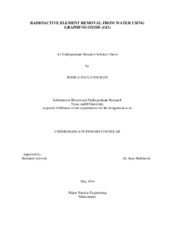| dc.description.abstract | The objective of this research is to test the ability of Graphene Oxide (GO) to attract and hold heavy radionuclides to be mechanically filtered out using an aluminum oxide ceramic filter. The radionuclides of interest are strontium-90, cesium-137 and uranium.
Naturally occurring radioactive materials (NORM) are abundant throughout the earth's crust. Human manipulation of NORM for economic ends, such as mining, ore processing, fossil fuel extraction, and commercial aviation, may lead to what is known as "technologically enhanced naturally occurring radioactive materials” (TENORM). The existence of TENORM results in an increased risk for human exposure to radioactivity. TENORM-producing industries may cause workers to be occupationally exposed to ionizing radiation and may release significant amounts of radioactive material into the environment resulting in the potential for widespread exposure. These industries include mining, phosphate processing, metal ore processing, heavy mineral sand processing, titanium pigment production, fossil fuel extraction and combustion, manufacture of building materials, thorium compounds, aviation, and scrap metal processing.
Treatment and decontamination of waste products and contaminated groundwater containing human-made radionuclides, among which the transuranic elements are the most toxic, is an essential task in the clean-up of legacy nuclear sites. The recent accident that included radionuclide release to the environment at the Fukushima Daiichi nuclear power plant in Japan, and the contamination of the water used for cooling its reactor cores, underscores the need for effective treatment methods of radionuclide-contaminated water.
This research hopes to find a less expensive and easier way of cleaning up radioactive accidents and leaks by demonstrating an ability of the GO to effectively and efficiently filter radionuclides from water sources such as rain water runoff or holding tank water. | en |


